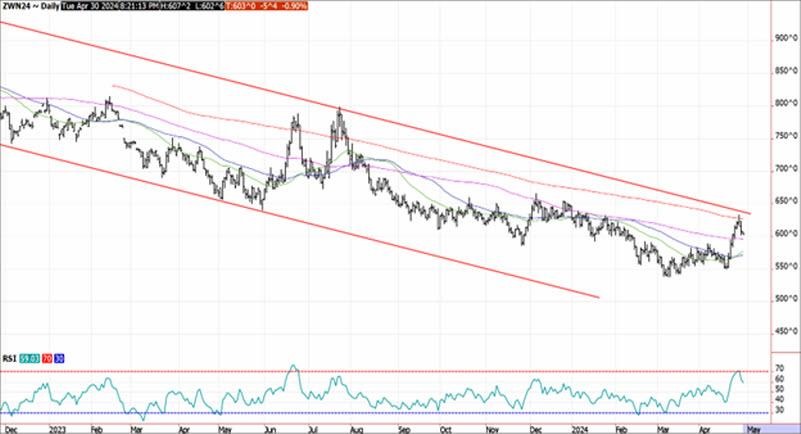This has been much to wheat farmers' chagrin as many in the industry struggle to make a profit when trying to sell their crop on a market flooded with cheap Russian wheat just ready to undercut them.
Recently, however signs have been pointing to relief for Canadian wheat farmers as global events have begun to push the price of wheat significantly higher for the first time in a long while. Farmers may be asking will this trend continue and, if so, to what extent?
The price of wheat has been rising thanks to a fund short covering rally where global funds have may been buying back their short positions from growing dry/frost weather concerns in the U.S. HRW country, Europe, Western Canada (the lack of moisture maybe getting more attention as planting season nears) and Southern Russia where most of the wheat is grown.
The other stress on crops has been from too much rain in Western Europe. This in turn sent European milling wheat prices higher supporting higher U.S. pieces. In the U.S., winter wheat crops got a small taste of frost in the Southwestern Plains on April 21 (Europe was worse) but a portion of the U.S. winter crop was headed and likely suffered some loss.
In the last 3 months Russia has seen very little moisture with some at 0% of normal. Concerns over crop prospects in Russia's southern Caucasus region have heightened. This area serves as a vital source of wheat exports for Russia.
Weather forecasts indicating prolonged dry conditions until early May have exacerbated worries about crop yields in this region. The lack of adequate rainfall poses a significant threat to wheat production, potentially impacting global supply, but now the weather forecast is calling for rain in the next few weeks just as the crop is being made.
With a production hiccup in Russian the worlds largest producer and exporter we could have a wheat rally. Some in the trade think that a 20 mmt hiccup is coming, which would reduce exports and drive demand up somewhere else and prices would need to rally to ration that demand.
On top of this potentially bullish news, India, one of the world's largest wheat producers and consumers, saw wheat stocks hit a 16-year low, down 25 percent vs. last year. Any imports from India to rebuild reserves would only add more fuel to the fire but talk of India buying wheat has been around since last year.
This unusual situation may lead to increased demand for wheat on the international market. Historically, India has been self-sufficient in wheat production and has not required substantial imports. However, poor harvests and dwindling stocks could prompt India to import large quantities of wheat, potentially driving up demand and prices worldwide.
Remember, India is the second largest consumer of wheat worldwide, beating out the U.S. by a wide margin. Should the country need to start importing wheat, it will likely be enough to push up global prices by itself.
Furthermore, more tensions in the Black Sea Region with recent Russian attacks on grain infrastructure in Odessa have added to the upward pressure on wheat prices (although this price increase is likely to be temporary as traders have lose interest in the war in Ukraine).
These assaults have disrupted grain transportation and storage facilities, leading to logistical challenges in grain distribution but the grain is still moving after two years. Initially, there was concern that the supply of wheat from the Black Sea region would be disrupted and people around the world would starve but other countries have come to the rescue.
The funds are being spooked after 2 months of their short positions no longer working. The wheat rally still has more legs left in it despite a rise of $0.95/bu in Chicago wheat futures as the funds -- despite covering 19,585 contracts from the February 2024 lows -- remain short 76,184 contracts as of April 23, 2024. A weekly close above the 200-day moving average at $6.277/bu and above the downtrend channel at $6.45/bu would be bullish.
2024 July Chicago Wheat Weekly Futures Chart

Chart Source: QTPlus
For daily information and updates on agriculture commodity marketing and price risk management for North American farmers, producers, and agribusiness visit the Farms.com Risk Management Website to subscribe to the program.